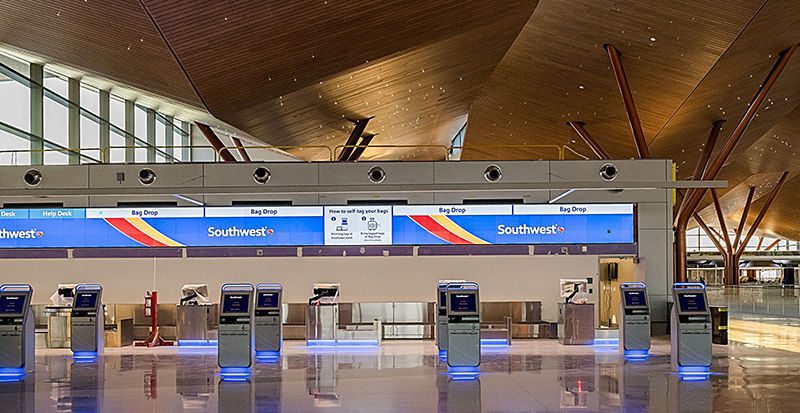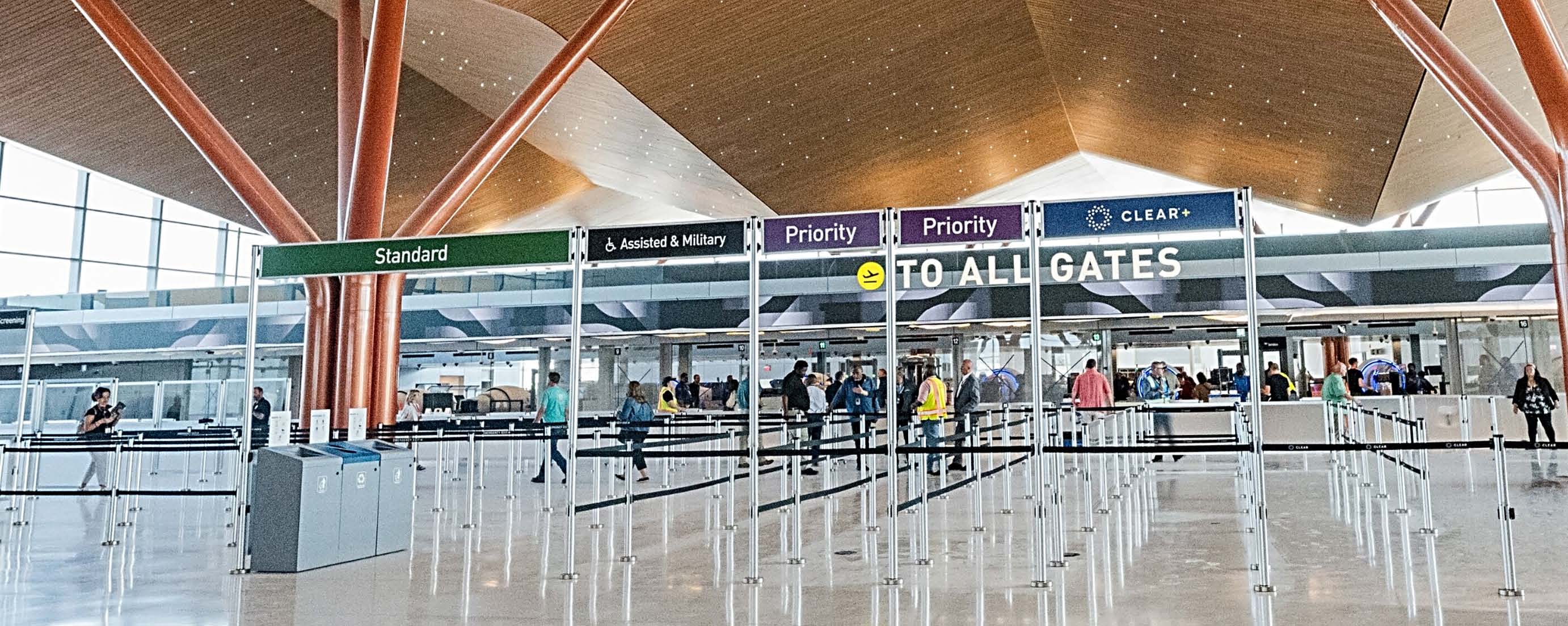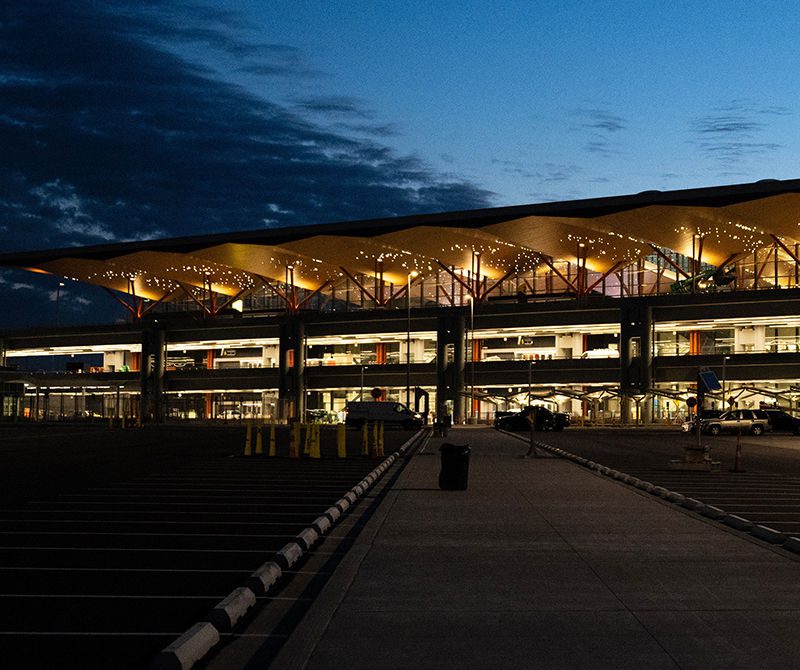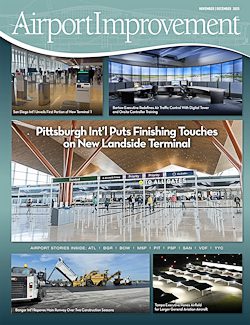In mid-October, Pittsburgh International Airport (PIT) cut the ribbon on its new $1.7 billion terminal in preparation for the subsequent fall public opening. Christina Cassotis, chief executive officer of the Allegheny County Airport Authority, which owns and operates PIT, says this ambitious modernization program will give Pittsburgh the airport it deserves. With a focus on improving passenger experience while also reflecting and connecting the community, the project features a new 811,000-square-foot landside terminal, roadway improvements, a multi-modal complex and an airside renovation.
 For Cassotis and her team, the project also became an opportunity to tell the story of Pittsburgh through building design, finish materials, art and the services provided at the airport. “That has been the guiding principle that’s led us,” she comments.
For Cassotis and her team, the project also became an opportunity to tell the story of Pittsburgh through building design, finish materials, art and the services provided at the airport. “That has been the guiding principle that’s led us,” she comments.
Beyond the Hub
To better understand and appreciate the new terminal, it’s helpful to examine PIT’s past. The Southwestern Pennsylvania airport was dealt a major blow when US Airways began dismantling its hub there in 2004. The airport’s X-shaped 1992-era terminal complex had been built largely for the airline, more specifically for its hub-and-spoke business model and connecting passengers.
| facts&figures
Project: Terminal Modernization Location: Pittsburgh Int’l Airport Owner/Operator: Allegheny County Airport Authority Cost: $1.7 billion New Terminal: 811,000 sq. ft. Parking Structure: More than 1 million sq. ft. Groundbreaking: Oct. 2021 Expected Completion: Fall 2025 Notable Features: 4 outdoor terraces; undulating ceiling with small lights that mimic local star constellations; 12-lane TSA checkpoint; 1,300-ft dual-level roadway bridge; interior pedestrian bridge/tunnel that links security checkpoint & airside areas; multi-story parking garage & new surface lots that triple covered parking & increase overall parking capacity Notable Strategies: Building new terminal on top of existing tunnels; closing down taxiway to create construction entrance Terminal Architecture & Engineering: Gensler + HDR, JV in association with luis vidal + architects Program Management: Jacobs Executive Management: Paslay Group Garage & Customer Service Building Architect & Engineer: Michael Baker Int’l Construction Management: PJ Dick/Hunt; Turner Construction Info Technology/Special Systems/Security/Life Safety Design: Burns Engineering Wood-Look Ceiling: Armstrong World Industries Baggage Systems: Daifuku Explosives Detection Machines: Smiths Detection Escalators: Schindler Platform for Stakeholder Engagement & Operational Readiness: Citiri Automated Parking Guidance System: TKH Security Parking Access & Revenue Control: Scheidt & Bachmann Snowmelters: Two Trecan 20-SG Snowmelters Key Benefits: Improved passenger experience; layout designed for origination & destination traffic (vs. previous connecting traffic); enhanced sustainability; 40-yr life expectancy with flexibility for future expansion |
On top of that, PIT faced a significant decline in passenger traffic after the 9/11 terror attacks and two bankruptcies of US Airways. In total, annual passenger numbers dropped from more than 20 million to under 8 million between 2002 and 2014. “From about 2005 to 2015, we were bleeding non-stop destinations and number of passengers,” says Paul Hoback, PIT’s chief development officer who recently transitioned to a new role as president and chief executive officer of Sarasota Bradenton International Airport.
When Cassotis was hired at PIT in 2013, she “saw an airport that had been abandoned by the very airline that asked the community to float the bonds to build their design.”
Her advice to the Airport Authority board was, and still is, that PIT can be a great origin and destination airport. “The hub model is not the only model of success,” she explains.
From an infrastructure perspective, the large, empty and outdated terminal no longer met the needs of or reflected the community it was supposed to serve. In the early 1990s, just 20% of traffic at PIT was origination and destination (O&D); today, it comprises 98%.
“We had an airport that was built to be a major connecting hub for the US Airways passenger,” Hoback says. “That time was gone.”
The original airside terminal has a central core with four concourses extending from it like the letter X, and a half-mile train ride separates it from the landside terminal. “We have lots of money tied up in infrastructure that doesn’t serve an O&D market,” Cassotis says. For instance, the airport has two separate baggage systems that aren’t linked, and eight miles of baggage belts.
She considers the Terminal Modernization Program an opportunity to create a facility that takes care of the origination and destination traveler.
Within the first couple of years after her arrival, PIT experienced significant success in air service development, expanding existing service and adding new nonstop routes. The focus then shifted to a master plan update and infrastructure improvements to create a facility that matched the new traffic. “And doing it in a way that truly reflects and serves this community and the global industry at the same time,” Cassotis adds. “To do that, we would focus on the people who use it—the passengers, the staff, the meeters and greeters, airport partners and people who might never even fly. By understanding what they need from the airport, we could build something really special.”
In 2013, airport officials engaged in a master planning process to determine what the future of PIT looked like and the best way to get there. Through that process, the project team developed its primary goals. First and foremost was to have stable and predictable costs to its airline partners, Hoback relates. “We really needed to have a solution that was a good return on investment that reduced our operation and maintenance costs.”
Maintaining a terminal designed for a completely different type of operation had become costly. “It was built to be a major connecting hub, and we were no longer that,” says Hoback. “We needed to rethink our facilities.
“There was zero flexibility,” he adds about the old layout. “We have to be flexible—aviation is constantly changing and evolving.”
Several alternatives to update and upgrade PIT were explored, including tearing down the airside terminal and building a new one connected to the landside facility, renovating all existing facilities, or continuing to operate out of the X-shaped airside terminal. However, none of those options provided the passenger experience and sustainable operating and maintenance costs leadership desired.
The plan ultimately selected eliminates the existing landside facility and constructs a new terminal headhouse that connects to the existing airside facility. Hoback notes that this achieves all of the Airport Authority’s primary goals: stable and predictable costs for airline partners, an improved passenger experience and alignment with the airport’s sustainability goals.
“And we wanted to build Pittsburgh’s airport, not US Airways’ airport,” he adds. “We wanted to build the proper front door to the region. We wanted an airport that was built for Pittsburgh, and, maybe more importantly, by Pittsburgh.”
Officials at PIT are proud to note that community input contributed to the design, and more than 90% of construction labor and materials are locally sourced.
Immersion Design Method
In a concerted effort to find the right project partners, the review and selection process for a design team involved organizational psychologists and problem-solving exercises. As Cassotis puts it, the Airport Authority didn’t want to build the chosen designer’s airport in Pittsburgh; it needed the designer to create Pittsburgh’s airport.
“It’s not about who shows you the coolest design. It’s about who can you work with,” she elaborates. “You have to make sure that the team you hire is going to be working with you, not telling you what you’re going to get. That, to me, is the most important thing.” Ultimately the Airport Authority chose the joint venture of Gensler and HDR in association with luis vidal + architects to design the ambitious terminal project.
Their new design philosophy for PIT was inspired by the natural environment, innovative spirit and community values of the region, which the airport boils down to three core elements: nature, technology and community. “Those elements define the region,” Hoback notes. They also guided the design team in creating an environmentally sustainable, culturally immersive airport, he adds.
 In order to deliver a facility that was truly representative of the region, Hoback says it was important to immerse the design team in the culture and history of Pittsburgh. In fact, Luis Vidal, president and founding partner of luis vidal + architects, chose to temporarily relocate to Pittsburgh so he could “sink into the culture of the city.” Walking and cycling through the city and surrounding countryside and talking to people allowed him to “feel the vibe of the city and really understand what Pittsburgh was about,” he says. Through this intentional immersion, Vidal discovered “an extremely proud city with a really rich history.”
In order to deliver a facility that was truly representative of the region, Hoback says it was important to immerse the design team in the culture and history of Pittsburgh. In fact, Luis Vidal, president and founding partner of luis vidal + architects, chose to temporarily relocate to Pittsburgh so he could “sink into the culture of the city.” Walking and cycling through the city and surrounding countryside and talking to people allowed him to “feel the vibe of the city and really understand what Pittsburgh was about,” he says. Through this intentional immersion, Vidal discovered “an extremely proud city with a really rich history.”
“Moving to Pittsburgh, understanding Pittsburgh, understanding its people, culture, its history, where they are going in the future, gave us a lot of clues on how to put this building together,” he relates. “Pittsburgh is all about the people, nature and technology.”
Arriving and departing PIT passengers were surveyed to understand their behaviors and preferences and gain a feel of what the community wanted in its airport, says Bill Peduzzi, aviation director of HDR and a native Pittsburgher. Working groups that included project stakeholders, subject matter experts and the airport groups that would ultimately operate in the new facility were integral in the early design stages.
 “The Authority afforded us the time to really explore the uniqueness of the challenge and to develop a solution that—in their words—was uniquely Pittsburgh,” Peduzzi says.
“The Authority afforded us the time to really explore the uniqueness of the challenge and to develop a solution that—in their words—was uniquely Pittsburgh,” Peduzzi says.
One of the “uniquely Pittsburgh” aspects is a high concentration of meeters and greeters. For many airports, this is an overlooked area, but for PIT, it became one of the focal points of design. “As a market that still likes to drop off and pick up friends, family and business associates at the airport, we had to make sure we had an arrival experience,” says Peduzzi.
Purely Pittsburgh
Vidal says the vibrant city has many attributes that captivated him and influenced the terminal design. Elements echo the region’s rolling hills, night sky and forests, while also emphasizing passenger comfort and freedom to create a unique and user-friendly airport experience. Functionally, the building is designed to improve the passenger journey. Separate levels for arriving and departing passengers make it intuitive and easy to reach the gate efficiently, with plenty of time to experience the retail and concessions if desired, explains Vidal.
As visitors approach the new PIT, a pavilion in the middle of a forest is revealed as the floating roof comes into view, he describes. Inside, the nods to nature continue, with columns that are tree-like structures, inspired by the forests of Western Pennsylvania, with a branching canopy design that supports the rolling roof, which mimics the area’s rolling hills.
Visitors are “completely immersed in the feeling and thought [of nature],” says Vidal.
Locally sourced wood, stone and steel are used throughout the new terminal, and the renovated airside center core is nearly the same square footage as Pittsburgh’s Market Square— a popular meeting, dining and entertainment area of the city. Natural light, which Vidal considers his “favorite building material,” fills the terminal through expansive windows that also offer scenic views of the rolling hills and airfield.
 Above, panelized metal planks from Armstrong World Industries cover the undulating interior and curbside ceiling. Designers specified a finish that looks like wood to give the spaces a warm, welcoming look. The planks inside the terminal are specially designed to provide acoustic benefits and access to the infrastructure behind it, notes Dan Holdridge, senior project manager of ProjectWorks Design and Specialty Solutions for Armstrong. At night, the wood-look ceiling appears to vanish and blend with the night sky because more than 4,000 lights are placed in the ceiling to mimic the constellations in the region.
Above, panelized metal planks from Armstrong World Industries cover the undulating interior and curbside ceiling. Designers specified a finish that looks like wood to give the spaces a warm, welcoming look. The planks inside the terminal are specially designed to provide acoustic benefits and access to the infrastructure behind it, notes Dan Holdridge, senior project manager of ProjectWorks Design and Specialty Solutions for Armstrong. At night, the wood-look ceiling appears to vanish and blend with the night sky because more than 4,000 lights are placed in the ceiling to mimic the constellations in the region.
“In aviation, you’re looking for every opportunity where you can make passengers feel more welcome, calmer,” Hoback says. “The visitor experience is going to be like no other in the United States—and maybe even the world.”
Originally, outdoor terraces had been value-engineered out of the design. But the COVID-19 pandemic highlighted the importance of outdoor spaces, both pre- and post-security, and an emphasis on public health and cleaner air brought them back. In total, the new terminal has four outdoor terraces—two pre-security, two post-security—that provide a calm, lush place for guests to relax and connect.
“This building could not be anywhere else,” Vidal says. “[It is] Pittsburgh-specific. When you design an airport, you have to think of the climate, location, the people—everything it has to offer.”
Hoback stresses that PIT is the first and last impression visitors have of the Pittsburgh region. “We’re delivering the front door it truly deserves,” he says.
“This airport reflects the new Pittsburgh in so many ways,” agrees Peduzzi.

The new terminal design caters to origination and destination travelers.
Acting primarily as “processors of people,” airports of the past have a reputation for not being user-friendly buildings, but the new PIT is far from that, says Vidal. “Our theory when designing an airport is completely the opposite—we put passengers first,” he explains. “That means passenger freedom to control what they do in the terminal—whether that’s work, dine, shop or simply get from door to gate extremely quickly.”
 Carolyn Sponza, Pittsburgh studio lead and principal at Gensler, says the design team developed seven to 10 iterations of how passenger flow could work in the new terminal. The team then conducted a “deeper dive” on the top three to five alternatives, analyzing key components of each option against the airport’s goals—such as walking distance and overall size to guard against overbuilding.
Carolyn Sponza, Pittsburgh studio lead and principal at Gensler, says the design team developed seven to 10 iterations of how passenger flow could work in the new terminal. The team then conducted a “deeper dive” on the top three to five alternatives, analyzing key components of each option against the airport’s goals—such as walking distance and overall size to guard against overbuilding.
The new terminal’s intuitive design and thoughtfully placed signage transform the visitor experience, Cassotis says. In addition, it takes passengers about half as long to get from curbside to airside, and the travel time between international arrivals and curbside was reduced by 67%.
The undulating ceiling that mimics a tree canopy was specifically designed to guide travelers through landside areas to the TSA checkpoint. “Even if you don’t have any idea where you’re going, you are naturally funneled into the space,” Sponza says.
Security screening was streamlined to create a much more efficient process. Rather than two checkpoints as in the old facility, the new terminal has a single, more open checkpoint with 12 lanes and state-of-the-art screening equipment that allows passengers to keep their shoes on and laptops in bags, thus reducing wait times.
The structure that links the security checkpoint to airside areas is a connector bridge and tunnel that emulates the city’s renowned entryway, Fort Pitt Bridge. Dynamic lighting and projections line the tunnel to recreate the Western Pennsylvania skylines for passengers.
Once airside, they will find a refreshed and expanded concessions program inspired by traveler feedback. It includes 15 new retail and dining options, with a mix of local, national and international brands.
Concourses have been updated with comfort and convenience in mind. The airport added new carpeting, LED lighting, flight information displays, modernized restrooms and improved seating with built-in power for charging electronics.
Passenger convenience and comfort were considered as much as possible, even with the smallest of details, Sponza says. For example, the doors on restroom stalls swing outward rather than inward. “Even though it seems like a super-small thing, whenever I bring someone to tour the space, they always comment on how they love the outward swinging doors because it’s much easier to use with luggage,” she explains.
A Terminal that Works
The airport is acknowledged as a focal point of the community with a design that reflects the city, puts the passenger first and maintains operational efficiency, Peduzzi relates.
He notes that architects redefined and amplified the passenger experience, from the view as guests enter airport roadways all the way to the gates. Ensuring there are enough decision points for passengers of varying needs was one important aspect. “Both frequent and infrequent travelers will appreciate the integrated, intuitive and efficient design,” Peduzzi says.
“We wanted to build a terminal that works for people, not just for corporations,” Cassotis says. That translated into universal access for all travelers and those who work there. Specific elements include clearly marked and intuitive wayfinding, real-time navigation tools and assistive technology, inclusive restrooms, companion care spaces, quiet rooms and sensory-friendly zones like Presley’s Place, a suite designed to support travelers with autism and sensory sensitivities.

The airport tripled its covered parking capacity and added 2,800 spaces in new surface lots.
The design also includes more opportunities for passengers to explore concessions and art, creating “aha moments” throughout the journey, Peduzzi adds.
“I think what makes it exceptional is that it’s a highly functional space that’s going to make people’s experience through the airport better and less stressful, but it’s also a beautiful piece of architecture,” Sponza says.
A redesigned and modernized baggage handling system decreases the baggage claim conveyor belt length from eight miles to just three. This results in shorter luggage travel time from plane to baggage claim and reduced operating and maintenance costs.
Sustainability was emphasized by the Airport Authority throughout the design and remains at the forefront while construction is finished, Sponza says. And it wasn’t just to “check the box in terms of a score card,” she specifies, but rather to do the right thing and have the most positive impact.
Rainwater collected from the new roofs is stored in tanks and used for irrigation in landscaping around the airport, including the new outdoor terraces. Procurement and use of local materials was prioritized, as was the recycling of construction waste, including 86,000 tons of crushed concrete reused for roads. The new terminal is expected to achieve LEED Gold Certification.
Coordinating Construction
Noting the timeline, Hoback identifies COVID-19 as the primary challenge faced during this project. In March 2020, the design was 90% complete. Then industry instability and uncertainty delayed final approval from airline partners and adjustments were needed.
The project had received unanimous verbal support from its airlines, but only two signatures, when the pandemic hit, Hoback recalls. Even with the industry in flux and so many unknowns looming, PIT leadership pressed on. “We didn’t just stop in the middle of the project,” Hoback explains. “We went on and did other enabling work and continued to refine the design.”

An undulating wood-look ceiling from Armstrong helps guide passengers to the new 12-lane TSA checkpoint.
Construction of a microgrid, five natural gas generators and installation of 10,000 solar panels on top of a former landfill all moved forward. Combined, these projects provide resilient electricity to the old and new terminals and are saving the airport more than $1 million per year in utility costs. PIT is the first airport in the world to be powered entirely by its own solar- and natural gas-powered microgrid, notes Hoback.
The forced pause caused by the pandemic provided the opportunity for the design team to make sure the terminal design met the Airport Authority’s goals in a post-pandemic world, which influenced some aspects of the project. For example, an eight-week charette with HDR’s healthcare experts addressed passenger and workplace safety, leading to changes in the HVAC systems and air handling in the new facility.
“I think all of the things we did during that period really paved the way for a very successful post-pandemic airport,” Sponza reflects.
Marrying the new terminal with the existing facility was another challenge. One particularly tricky transition was in the baggage claim hall. “Those floor heights did not match up at all with the existing building, so we needed to make some adjustments to make sure that everything lined up perfectly,” says Sponza.
 Construction logistics were complex, as with any project at a busy airport. Hoback relates the process to changing the tires on a speeding car. “And I think our team here in Pittsburgh really did that brilliantly,” he remarks. Considering all of the work that would occur throughout the 811,000-square-foot project, it was evident that managing the flow of construction equipment, supplies and workers to and from the job site would be a tremendous challenge. To facilitate work while also reducing impact to operations and airport roadways, PIT got creative. Early in the planning process, site logistics and construction phasing were assessed and working in partnership with FAA, the airport closed down Taxiway B on the north side of the airfield and used it as a secure construction entrance to the site. This kept construction vehicles off of the major public roadways and out of traffic circulating on airport roadways.
Construction logistics were complex, as with any project at a busy airport. Hoback relates the process to changing the tires on a speeding car. “And I think our team here in Pittsburgh really did that brilliantly,” he remarks. Considering all of the work that would occur throughout the 811,000-square-foot project, it was evident that managing the flow of construction equipment, supplies and workers to and from the job site would be a tremendous challenge. To facilitate work while also reducing impact to operations and airport roadways, PIT got creative. Early in the planning process, site logistics and construction phasing were assessed and working in partnership with FAA, the airport closed down Taxiway B on the north side of the airfield and used it as a secure construction entrance to the site. This kept construction vehicles off of the major public roadways and out of traffic circulating on airport roadways.
“Everything is completely off the airport roadway system because we used a different interchange off of our interstate highway system and connected that interchange to Taxiway Bravo with a new roadway,” Hoback explains. With up to 1,400 construction workers each day at peak times, this had a significant effect.
“In addition to airport security, we had in place a terrific safety and security program to control access on and off site, allowing the complete separation of construction traffic and airport passenger and employee traffic,” Peduzzi adds.
Special care was taken during work above and near the seven underground tunnels that allow goods, tugs, baggage and people to move between the two existing terminal buildings, which are a half-mile apart. The tunnels and trains that pass through them had to remain operational throughout construction.
Drilling foundations, erecting structural steel and other work occurring above the tunnels required significant coordination. “From the earliest parts of the project, we needed to structurally plan not to disturb operation of the train for the period of construction,” says Sponza. Structural and civil engineering teams worked closely to develop a girder system or “rib cage” that spanned the train tunnels, locating all the building foundations on either side, she explains.
Challenges also occurred above ground. At any one time, 16 to 20 cranes were operating on the airport, which required careful coordination with the FAA air traffic control tower and Operations Department. “It’s an orchestra that’s happening out there,” Hoback says. “Everybody’s playing their own instruments, and when everybody is doing it the right way, it sounds like a beautiful symphony.”
Operational Readiness
At the end of September, PIT’s Terminal Modernization Project was estimated to be 94% complete. Only construction that couldn’t occur until after opening day remained, notes Hoback.
At that point, training, testing and commissioning took center stage, although testing had been occurring for several months. To help identify potential problems and ensure functional success before the official public debut, the airport organized a series of operational test runs. Its multi-tier approach included basic trials of one element or system, advanced trials combining multiple elements, and then integrated trials with hundreds, even thousands, of people invited to the terminal to test the full system at work.
“We’re learning with every trial, and trying to find things that we need to fix so we can make sure opening day is just like any other day at the airport,” Hoback commented in late September.
The first public trial, held on Saturday, Sept. 20, involved 300 participants testing systems and processes from check-in, to TSA, to baggage handling. About 2,000 participants are expected for the second trial scheduled for Oct. 25. This “full-scale dress rehearsal” is designed to replicate what a typical day at PIT will look and feel like, ensuring the systems, airport department and partners are ready to operate the new terminal.
PIT’s in-house Operational Readiness, Activation and Transition (ORAT) team, led by Daniel Bryan, has been closely embedded with the project from the beginning. “Bringing ORAT in at design enables the building to be shaped around the operation rather than the operation having to work around the building,” he notes.
Operational readiness extends beyond the facility to include airport personnel, Hoback adds. Roughly a year ago, PIT created a team comprised of members from each department within the airport and partner organizations to coordinate training and familiarization with all new processes and equipment.
The airport used Citiri’s platform to manage and coordinate the ORAT process and stakeholder engagement. The sheer volume of tasks and processes involved underscores the need for a centralized system. Elements tracked and supported include 300+ training sessions for 2,000+ participants, 8,500+ trial registrations, communications with 21,000+ contacts and many more.
 Citiri Chief Executive Officer Ortez Gude lauds Cassotis for applying the same rigor to ORAT as design and construction. “One example of that is how she made it clear to everyone that the critical trial period would be protected at all costs,” he explains.
Citiri Chief Executive Officer Ortez Gude lauds Cassotis for applying the same rigor to ORAT as design and construction. “One example of that is how she made it clear to everyone that the critical trial period would be protected at all costs,” he explains.
Curbside and Parking Operations
Approximately four miles of new roadway were constructed to connect Interstate 376 and the new terminal with a network of ramps and small bridges. Directional signage shows local pride by using the colors of the city’s professional football, baseball and hockey teams. Outdoor signs have a white background with black lettering, matching the away jerseys, while indoor signs are black with gold lettering, just like the home jerseys.
Pedestrian and vehicle traffic only intersect at the commercial curb level, where traffic is much less dense. The three-level, 12-lane roadway not only functions to organize and simplify traffic and pedestrian routes, it also presented an architectural opportunity.
In the “City of Bridges,” the new 1,300-foot bridge in front of the terminal is now Pittsburgh’s longest. Peduzzi explains that the in-plane trapezoidal box girder bridge is much thinner than typical structures that allow vehicles to pass at heights typically reserved for buildings. The dual-level terminal front bridge is one example where engineering technology really shines on this project, he adds. It needed to be thin enough to allow vehicles to pass at each level between the floor plates, but strong and resilient enough to carry the associated loads. “We wanted to thin out that structure as much as we could so that you could see the beautiful building behind it,” Peduzzi explains. The bridge is built on ten pier sets with 68 tub girders, and required 8 million pounds of structural steel to construct.
Panels for noise suppression are integrated into all three levels of the roadway, along with LED lighting that is brighter at the crossing points to aid wayfinding. Replacing large pendant lights with puck lighting embedded into the ceiling visually declutters the entire curbfront, Peduzzi says.
Having an integrated project team was especially valuable when developing the terminal curb—an area with many competing purposes including baggage drop off, bollards to protect pedestrians and amenities for waiting passengers. “We were able to take a lot of those needs and meet them in ways that also cleaned up the curb,” Peduzzi remarks. There are benches made from local stone for guest comfort, planters for beautification and bollards for safety.
The new six-story multi-modal complex is travelers’ link to a variety of ground transportation options. It includes a fully enclosed customer service building that is connected by a covered walkway to a new parking garage, with direct access to a curb for buses, taxis and the rideshare vehicles.
New parking facilities triple the amount of covered parking at PIT. The project added a multi-story parking structure with 3,200 spaces and new surface lots with 2,800 spaces. The new garage includes an Automated Parking Guidance System from TKH Security for enhanced efficiency, security and safety. Other features include electric vehicle charging stations and Pittsburgh-theme signage. Two stationary Trecan 20-SG snowmelters were installed on the top deck to help preserve parking spaces on the open-air level during winter storms. Each is capable of melting 40 tons of snow per hour and runs on natural gas instead of diesel fuel.
Lessons Learned
An integrated design team of architects, engineers, environmental specialists and artists played a key role in creating a facility that meets the Airport Authority’s goals. The multi-discipline approach allowed for quicker iteration and better design outcomes, with all voices present to address issues in real-time, says Peduzzi.

The concessions program was expanded based on traveler input.
Involving maintenance and operations personnel early in the design/planning process is immeasurably beneficial, Hoback advises. Prior to paint application, maintenance workers tested the paint architects specified for structural tree-like columns in the terminal to help prepare for future touch-ups. “The fumes were so noxious that we would have had to shut down the airport for repainting even just a small section,” he relates. That led maintenance crews to suggest covering the bottom 8 feet of the columns—portions more likely to suffer dings and nicks—with a different type of paint. This “give and take relationship” happened throughout the design process because of the close, early partnership of all stakeholders, Hoback reports.
Early meetings, particularly with operations and maintenance teams, provided valuable insight. “It’s important input that you need from the beginning of the project and that very much influenced our decision-making and documentation along the way,” Sponza agrees.
A simulated 3D fly-through of the project helped stakeholders identify and correct possible hinderances to the passenger experience. “When you look at a two-dimensional drawing, you’re not really seeing what the experience is going to be,” Hoback relates. For example, pendant lights that appeared to work well on paper proved otherwise after a 3D fly-through look at the space.
Community Engagement
Cassotis attributes much of the project’s success to effective collaboration with the airlines and industry partners, as well as strong community support. “To engage the community was actually very easy,” she reflects. “This community cares so much about its airport. There’s a real sense of pride that Pittsburgh was picked by US Airways to be its largest connecting hub, and a wistfulness that they want to be proud again.”
That spirit was displayed by the 18,000+ people who registered to participate in operational trials to help ready the airport for opening day and 10,000 who registered for a Community Open House. The request for volunteers was issued only through Blue Sky News, an in-house news service.
“People care about this airport,” Cassotis remarks. Although involving the community was easy, it was important to involve them thoughtfully, she adds. As such, management is using the opportunity presented by the new terminal project to educate and inform the community about PIT’s regional impact and how it operates, particularly in terms of funding.
Cassotis cites working with the community and industry as the most rewarding aspect of the entire project.
Looking to the Future
The Terminal Modernization Program is an economic engine estimated to create 14,300 jobs and $2.5 billion in economic activity.
In 2015, airlines served 36 nonstop destinations from PIT; today, that number is 62 and the number of airlines has doubled, which means local travelers have many more options. Moreover, the frequency of flights and aircraft gauge have increased, and international service has returned. After a two-decade absence, British Airways is once again offering nonstop service to Heathrow Airport (LHR) in London.
“It’s a big deal that this community has airline service that matches what it needs today and what it’s likely to need in the future,” Cassotis comments.
It’s the community and a local history of innovation that made this project, she says. “It’s a big ‘What if?’ community, and we were able to replicate that here at the airport.”
The new terminal is built with flexibility in mind. As it sits, physical expansion—if needed—could occur both to the north and south. Facilities are designed to handle up to 18 million passengers per year, even though current projections estimate PIT will end 2025 with a passenger count of 10 million.
After the new terminal opens, the existing landside terminal could ultimately be demolished; but that has not been scheduled. Until then, the airport may explore short-term lease opportunities. Once cleared, the space could be used for commercial development. “It’s prime real estate and we’ll use it in the best way that we can for our airport,” Hoback says.
“There’s always opportunity in this industry, and that’s what makes it so exciting,” Cassotis says. One of the next opportunities at PIT is a sustainable aviation fuel/hydrogen production facility. The airport is partnering with regional businesses, universities and various governmental agencies to construct an on-site plant capable of supplying sustainable aviation fuel to passenger and cargo airlines operating at PIT, plus more to export to other markets.




